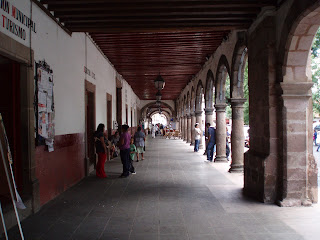Air Pollution and Urban Intensity
Of course it's all a matter of perspective, and ours is shaped by moving here from an isolated, beautiful small town (population 10,000) in the mountains of New Mexico, with clean air and endless trails for hiking and biking. Before that we lived at Lake Chapala for two years, and while the carretera (the highway that is the only way into or out of the area) is heavily trafficked, the lakeshore villages themselves are mellow and walkable, while being on water and a small population keeps the air reasonably clean.
Recently it's come to our attention that there's a substantial cluster of brick making ovens located all around the periphery of San Miguel, with the biggest concentration just south of the city limits. These are illegal businesses that survive because they provide much-needed employment, but the fumes they produce, especially with the truckloads of computer parts, plastics and tires that city-owned and operated trucks have been delivering to them, are very toxic. Here's a video shot by a local group trying to address this issue:
http://www.youtube.com/watch?v=ISqd85i88tw&feature=youtu.be
Unlike Mexico City, where sophisticated air pollution measurement is in place (thereby allowing one to know that every day spent there is the equivalent of smoking 40 cigarettes), air pollution in San Miguel is hard to quantify. Anecdotal evidence from friends and local doctors is not encouraging, and for my part long-standing sinus issues have certainly gotten worse since we've moved here, while my wife, who rarely has so much as a cold, has experienced frequent headaches and coughing.
Brick ovens aside, we lead an exceedingly urban existence here without a car, due to the unique layout of San Miguel and its tremendous growth in recent years. We avoid walking on the major streets when possible, but often that isn't possible and even the back streets have traffic at all times of day except for very early morning or very late at night. The streets here are also all cobbled, uneven and full of gaps, holes and protruding objects, while sidewalks are so narrow that two people can't walk side by side and passing often requires stepping out into the street and dodging traffic. You have to be on your toes and looking down and around at all times. It's far more demanding than Lake Chapala or anywhere else we've been in Mexico - closer really to Bali or Chiang Mai in terms of intensity and need for constant vigilance. There are a couple of pocket parks in town and the wonderful botanical gardens a steep half-hour hike away, but that is it for relief from traffic, buses spewing diesel fumes and dodging people and vehicles while walking around. So while greater San Miguel is less than 200,000 people, it has an intensity of "urbanness" that's easily the equal to, say, Paris or New York, albeit in a uniquely third-world way.
The expat community: a world of well-heeled coming and goings
San Miguel is even more transient in its expat population than Lake Chapala, with people coming and going not just for high and low season but constantly. "Long term" in rental ads here means 3 months or more (vs. a year + anywhere else we've lived), and easily half the people we've met thus far are just back from trips to the U.S., Asia or Europe or gearing up for them.
The commitment phobia we got used to at Lakeside for any sort of scheduled or recurrent activity, from book groups to meditation, yoga or other classes, is even stronger here, and that plus all of the coming and going has a profound effect on one's emotional investment in potential friendships. All in all, what we're seeing is that the expat groups here and at Lake Chapala are far more similar than they are different.
Preliminary conclusions
I've said before that the snowbirds (and "sweatbirds" - those who come to the highlands of Mexico during the rainy season to escape the heat of Texas, Arizona or Florida) have it right, and I still think that's the case, at least for us. That said, being able to afford to have two home bases, and dealing with the attendant costs, is a huge hurdle for many, including ourselves.
The choice between San Miguel de Allende and Lakeside boils down to opting for a bustling city with plenty going on (far too much, when it comes to pollution and traffic), vs. generally pretty sleepy villages with perhaps too little activity, choice of food and restaurants, culture, etc. but where one has a sense of living in a calming natural setting, yet with easy access to an airport and a city of 6 million with every urban amenity imaginable. From my point of view the ideal would be to spend time in both of these places, never own property in either, travel light and keep one's options open. Regarding the much-publicized dangers, I'm a lot more concerned about breathing the air in San Miguel than I am worried about the statistically miniscule chance of being a victim of narco crime either at Lake Chapala or here. Heck, it's the prospect of heading back to the U.S. that really terrifies in that regard (remind me not to attend any midnight movie showings or visit any Sikh temples.....), while the real terror sets in when I think of the prospect of negotiating the health care and insurance systems. Those very real fears notwithstanding it seems clear that if we can find a way to be U.S. based visitors to Mexico we'll be far happier in the long run.






















